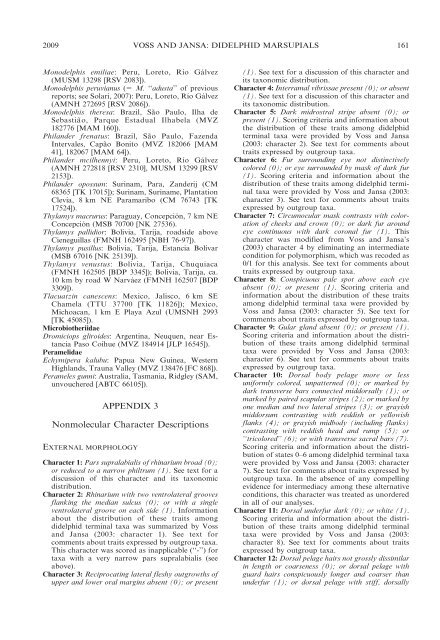phylogenetic relationships and classification of didelphid marsupials ...
phylogenetic relationships and classification of didelphid marsupials ...
phylogenetic relationships and classification of didelphid marsupials ...
You also want an ePaper? Increase the reach of your titles
YUMPU automatically turns print PDFs into web optimized ePapers that Google loves.
2009 VOSS AND JANSA: DIDELPHID MARSUPIALS 161<br />
Monodelphis emiliae: Peru, Loreto, Río Gálvez<br />
(MUSM 13298 [RSV 2083]).<br />
Monodelphis peruvianus (5 M. ‘‘adusta’’ <strong>of</strong> previous<br />
reports; see Solari, 2007): Peru, Loreto, Río Gálvez<br />
(AMNH 272695 [RSV 2086]).<br />
Monodelphis theresa: Brazil, São Paulo, Ilha de<br />
Sebastião, Parque Estadual Ilhabela (MVZ<br />
182776 [MAM 160]).<br />
Phil<strong>and</strong>er frenatus: Brazil, São Paulo, Fazenda<br />
Intervales, Capão Bonito (MVZ 182066 [MAM<br />
41], 182067 [MAM 64]).<br />
Phil<strong>and</strong>er mcilhennyi: Peru, Loreto, Río Gálvez<br />
(AMNH 272818 [RSV 2310], MUSM 13299 [RSV<br />
2153]).<br />
Phil<strong>and</strong>er opossum: Surinam, Para, Z<strong>and</strong>erij (CM<br />
68365 [TK 17015]); Surinam, Suriname, Plantation<br />
Clevia, 8 km NE Paramaribo (CM 76743 [TK<br />
17524]).<br />
Thylamys macrurus: Paraguay, Concepción, 7 km NE<br />
Concepción (MSB 70700 [NK 27536).<br />
Thylamys pallidior: Bolivia, Tarija, roadside above<br />
Cieneguillas (FMNH 162495 [NBH 76-97]).<br />
Thylamys pusillus: Bolivia, Tarija, Estancia Bolívar<br />
(MSB 67016 [NK 25139]).<br />
Thylamys venustus: Bolivia, Tarija, Chuquiaca<br />
(FMNH 162505 [BDP 3345]); Bolivia, Tarija, ca.<br />
10 km by road W Narváez (FMNH 162507 [BDP<br />
3309]).<br />
Tlacuatzin canescens: Mexico, Jalisco, 6 km SE<br />
Chamela (TTU 37700 [TK 11826]); Mexico,<br />
Michoacan, 1 km E Playa Azul (UMSNH 2993<br />
[TK 45085]).<br />
Microbiotheriidae<br />
Dromiciops gliroides: Argentina, Neuquen, near Estancia<br />
Paso Coihue (MVZ 184914 [JLP 16545]).<br />
Peramelidae<br />
Echymipera kalubu: Papua New Guinea, Western<br />
Highl<strong>and</strong>s, Trauna Valley (MVZ 138476 [FC 868]).<br />
Perameles gunni: Australia, Tasmania, Ridgley (SAM,<br />
unvouchered [ABTC 66105]).<br />
APPENDIX 3<br />
Nonmolecular Character Descriptions<br />
EXTERNAL MORPHOLOGY<br />
Character 1: Pars supralabialis <strong>of</strong> rhinarium broad (0);<br />
or reduced to a narrow philtrum (1). See text for a<br />
discussion <strong>of</strong> this character <strong>and</strong> its taxonomic<br />
distribution.<br />
Character 2: Rhinarium with two ventrolateral grooves<br />
flanking the median sulcus (0); or with a single<br />
ventrolateral groove on each side (1). Information<br />
about the distribution <strong>of</strong> these traits among<br />
<strong>didelphid</strong> terminal taxa was summarized by Voss<br />
<strong>and</strong> Jansa (2003: character 1). See text for<br />
comments about traits expressed by outgroup taxa.<br />
This character was scored as inapplicable (‘‘-’’) for<br />
taxa with a very narrow pars supralabialis (see<br />
above).<br />
Character 3: Reciprocating lateral fleshy outgrowths <strong>of</strong><br />
upper <strong>and</strong> lower oral margins absent (0); or present<br />
(1). See text for a discussion <strong>of</strong> this character <strong>and</strong><br />
its taxonomic distribution.<br />
Character 4: Interramal vibrissae present (0); or absent<br />
(1). See text for a discussion <strong>of</strong> this character <strong>and</strong><br />
its taxonomic distribution.<br />
Character 5: Dark midrostral stripe absent (0); or<br />
present (1). Scoring criteria <strong>and</strong> information about<br />
the distribution <strong>of</strong> these traits among <strong>didelphid</strong><br />
terminal taxa were provided by Voss <strong>and</strong> Jansa<br />
(2003: character 2). See text for comments about<br />
traits expressed by outgroup taxa.<br />
Character 6: Fur surrounding eye not distinctively<br />
colored (0); or eye surrounded by mask <strong>of</strong> dark fur<br />
(1). Scoring criteria <strong>and</strong> information about the<br />
distribution <strong>of</strong> these traits among <strong>didelphid</strong> terminal<br />
taxa were provided by Voss <strong>and</strong> Jansa (2003:<br />
character 3). See text for comments about traits<br />
expressed by outgroup taxa.<br />
Character 7: Circumocular mask contrasts with coloration<br />
<strong>of</strong> cheeks <strong>and</strong> crown (0); or dark fur around<br />
eye continuous with dark coronal fur (1). This<br />
character was modified from Voss <strong>and</strong> Jansa’s<br />
(2003) character 4 by eliminating an intermediate<br />
condition for polymorphism, which was recoded as<br />
0/1 for this analysis. See text for comments about<br />
traits expressed by outgroup taxa.<br />
Character 8: Conspicuous pale spot above each eye<br />
absent (0); or present (1). Scoring criteria <strong>and</strong><br />
information about the distribution <strong>of</strong> these traits<br />
among <strong>didelphid</strong> terminal taxa were provided by<br />
Voss <strong>and</strong> Jansa (2003: character 5). See text for<br />
comments about traits expressed by outgroup taxa.<br />
Character 9: Gular gl<strong>and</strong> absent (0); or present (1).<br />
Scoring criteria <strong>and</strong> information about the distribution<br />
<strong>of</strong> these traits among <strong>didelphid</strong> terminal<br />
taxa were provided by Voss <strong>and</strong> Jansa (2003:<br />
character 6). See text for comments about traits<br />
expressed by outgroup taxa.<br />
Character 10: Dorsal body pelage more or less<br />
uniformly colored, unpatterned (0); or marked by<br />
dark transverse bars connected middorsally (1); or<br />
marked by paired scapular stripes (2); or marked by<br />
one median <strong>and</strong> two lateral stripes (3); or grayish<br />
middorsum contrasting with reddish or yellowish<br />
flanks (4); or grayish midbody (including flanks)<br />
contrasting with reddish head <strong>and</strong> rump (5); or<br />
‘‘tricolored’’ (6); or with transverse sacral bars (7).<br />
Scoring criteria <strong>and</strong> information about the distribution<br />
<strong>of</strong> states 0–6 among <strong>didelphid</strong> terminal taxa<br />
were provided by Voss <strong>and</strong> Jansa (2003: character<br />
7). See text for comments about traits expressed by<br />
outgroup taxa. In the absence <strong>of</strong> any compelling<br />
evidence for intermediacy among these alternative<br />
conditions, this character was treated as unordered<br />
in all <strong>of</strong> our analyses.<br />
Character 11: Dorsal underfur dark (0); or white (1).<br />
Scoring criteria <strong>and</strong> information about the distribution<br />
<strong>of</strong> these traits among <strong>didelphid</strong> terminal<br />
taxa were provided by Voss <strong>and</strong> Jansa (2003:<br />
character 8). See text for comments about traits<br />
expressed by outgroup taxa.<br />
Character 12: Dorsal pelage hairs not grossly dissimilar<br />
in length or coarseness (0); or dorsal pelage with<br />
guard hairs conspicuously longer <strong>and</strong> coarser than<br />
underfur (1); or dorsal pelage with stiff, dorsally

















